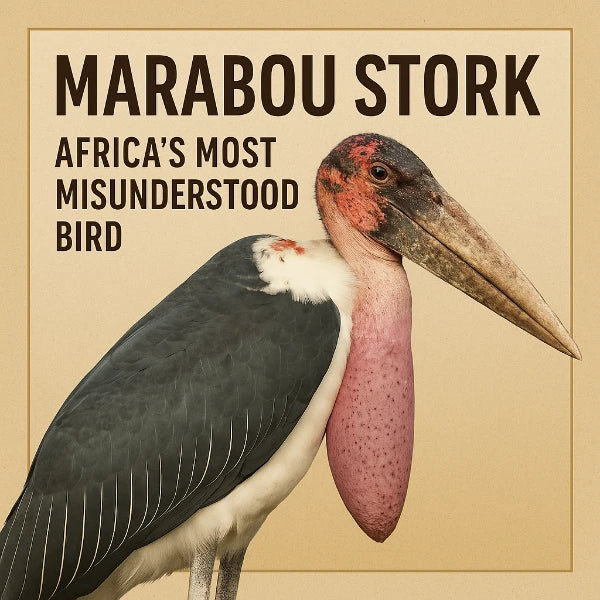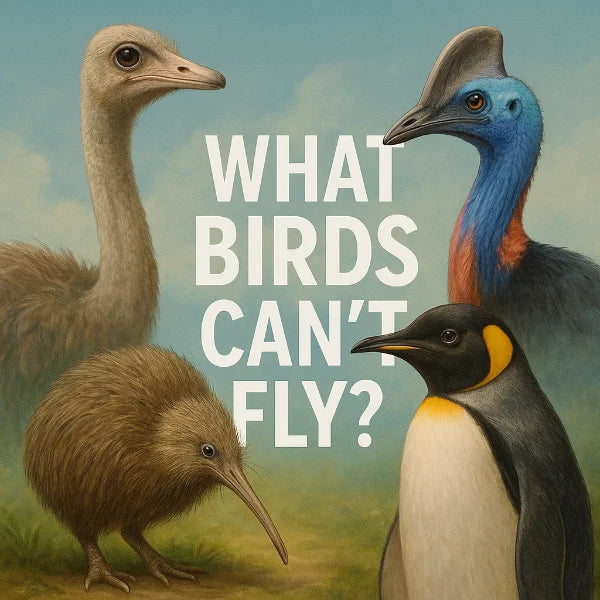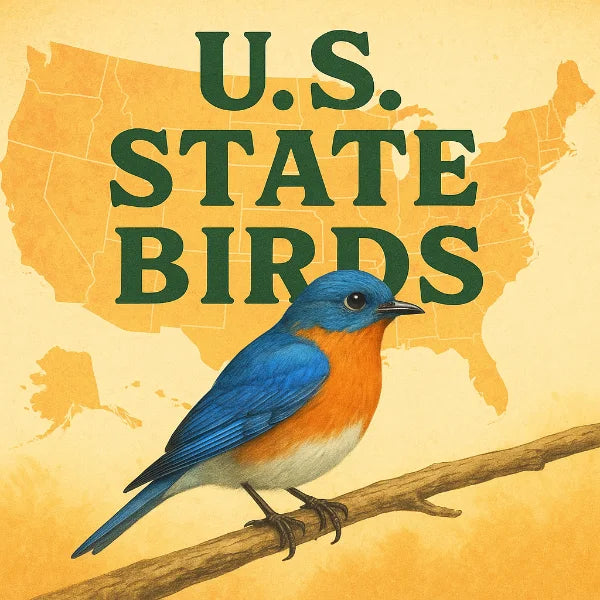There's ugly, and then there's the Marabou Stork. Due to its unusual appearance, this giant, vulture-like bird has been called "nature's eyesore" or "the undertaker on stilts." But it's not here to haunt your safari nightmares. This massive bird is one of the most efficient recyclers in the world. From stripping carcasses to pest control, it does the dirty jobs that keep Africa’s ecosystem running.
In this article, we're stripping away the "ugly bird" tag and showing why this bird deserves more admiration. If you think nature's MVPs are all sleek and rainbow-hued, you'd be mistaken. The Marabou demonstrates that occasionally, saving the world isn't always glamorous, but someone has to step up.

What’s in a Name
The name "Marabou" has Arabic origins. It comes from the Arabic word murābit, meaning a "holy man" or "quiet" man. Early European naturalists were convinced that the bird's still, stoic posture was reminiscent of a praying monk.
The scientific name Leptoptilos crumenifer has Greek and Latin origins. Leptos means "thin," ptilos means "feathers," and crumenifer means "purse-bearer," a reference to their bizarre throat pouch. So, yes, this bird's name literally means "slender-feathered purse-carrier." And yet, somehow, it works.

Towering Stats and Bizarre Features
Physically, the Marabou is one of the world's largest flying birds. Adults stand 4 to 5 feet high, with a wingspan of 8 to 10 feet. They weigh up to 20 pounds but fly like gliders because they have hollow, air-filled bones, even in their toes.
They have an enormous bill, measuring 10–14 inches, perfect for tearing flesh. Their heads and necks are completely bald, which is a built-in cleanliness system for dealing with dead animals. Their legs are often coated in white streaks, and no, that's not dust or chalk. It's uric acid from a behavior called urohidrosis, basically defecating on their legs to cool down.
On the ground, it's another story altogether. The bird walks with its back bent, dragging its heavy bill along. And although the Marabou does not possess a voice box, it still has a way of "speaking." It produces low croaks, employing that throat sac when it is courting, and pairs will ring their huge bills together.

Habitat: Where the Grim Stork Roams
Marabou Storks inhabit sub-Saharan Africa, from Senegal to South Africa. They are commonly found near wetlands, lakes, and rivers, where fish and carcasses are plentiful. But they're adaptable and often venture into dry savannas, open grasslands, and city landfill sites.
Yes, landfills. In urban areas such as Nairobi, they rummage through mounds of garbage for food. They also congregate near slaughterhouses and fish markets. Their familiarity with human environments makes them fascinating and problematic due to their exposure to plastics and heavy metals.
In Botswana, some storks’ regurgitated contents contained over 125 grams of plastic pellets. This study reveals a gut-wrenching truth about what these birds must eat when they forage on human garbage.

What's for Dinner
Marabou are obligate scavengers, which means they're built to feed on the dead. They love roadkill, decomposing carcasses, meat waste, and entrails; they love it all. Their enormous wedge-shaped bill is perfect for ripping into decomposing flesh, tearing through sinew, and rummaging inside carcasses.
Their bald head and neck are not an evolutionary mistake. Their bare skin ensures they don’t get smeared with blood and innards as they feed. After eating, they regurgitate the indigestible parts of bones, hair, and plastic into tidy, pellet-like clumps. It's disgusting but also efficient.
They are also opportunistic predators. They prey on frogs, fish, snakes, rodents, termites, grasshoppers, and even eggs and chicks stolen from nests. Marabous have even been known to steal baby birds when adult flamingos turn their backs.
Research shows that city Marabous eat more carbohydrates and processed foods like bread and fruit than their rural cousins. Landfill storks often regurgitate pellets of plastic eaten and carry higher concentrations of heavy metals like lead and zinc.

Family Life: Not Exactly Cuddly
Marabous are monogamous and will colonially breed with other waterbirds like ibises or herons. During courtship, the male inflates his pink sac, rattles his bill, and puffs out his feathers to impress the female. The two then build a large stick nest, often high in a tree or on an artificial platform.
The female lays 2–3 pale blue-green eggs. Both parents incubate the chicks for 30–35 days, taking turns sitting and feeding them. The chicks are helpless at birth and grow slowly, typically staying in the nest for three months.
Often, only one chick out of a brood survives due to food shortages or sibling competition. Even after fledging, juveniles remain near their parents, begging for food like awkward teenagers who never quite leave home.

Social Life of a Scavenger
Marabou Storks may seem distant, but they're actually very social, especially if food or breeding space is on the line. They gather at dumps, lakes, and roosting sites, using body language and bill-clattering to keep the peace. They lack a syrinx and cannot sing; they communicate with low croaks, bill chattering, and by inflating their throat sac.
They're proficient gliders, soaring on thermal currents with ease, and are seen circling like vultures. Unafraid and curious, they walk through markets, loiter outside restaurants, and thrive in human towns. Alone one moment, the next in a noisy flock, marabous live in a world of extremes.

Why People Call It “the Undertaker”
Marabou Storks look like they belong in a Tim Burton movie. From behind, its hunched shoulders, drooping black wings, and long, skinny legs all add up to the "undertaker" reputation. The bird is associated with death, spirits, or bad luck in certain African mythologies.
The marabou reputation has also found its way into pop culture. You’ll spot it in documentaries, creepy memes, and even as inspiration for fictional monsters. Despite its fearsome appearance, this bird is not an evil beast; it's nature’s unsung hero.

Role in the Ecosystem: Nature's Grim Reaper and Hero
Marabou Stork is one of the best clean-up teams in the animal kingdom. As a scavenger and opportunistic predator, it eats carcasses, controls pests, and controls disease. They use their good eyesight to locate carcasses or trail vultures to scraps, ripping flesh with their powerful bill. It does its dirty job to prevent the spread of fatal parasites and bacteria.
Marabous feed on termites, locusts, rats, and snakes while pest-controlling without incurring a dime. In towns, they manage waste and prevent vermin at dumps and fish markets. As keystone species, they play a vital role in ecosystem health. Often overlooked due to their looks, such birds are ecological MVPs, maintaining both natural and human-altered environments.

Threats and Decline
The IUCN Red List currently lists the Marabou as Least Concern. This ranking is based on its wide range and strong populations in parts of East and Southern Africa. But that rank conceals extreme regional hardship. In West Africa, they are declining, with many former nesting colonies disappearing completely over the last decades. In countries like The Gambia, Benin, and Nigeria, breeding pairs are now in the dozens, not hundreds.
And there's a conservation blind spot. These birds aren't cute or cuddly. They don't get the same headlines as flamingos or cranes. But their ecological value is just as important. Preserving wetlands, disposing of waste effectively, and recognizing their value are the ways to keep their populations at healthy levels.

Final Thoughts
As our encounter with the Marabou draws to an end, one thing is certain: beauty is not everything. Designed for survival and service to the environment, it does what it has to do, and it doesn't need awards. If ugly is functional, then the Marabou is one of nature's masterpieces.
If you’re intrigued by nature’s most unusual birds, don’t miss our deep dive into the ghostly Potoo and the strikingly gothic Dracula Parrot—two more feathered marvels that defy expectations.

FAQs
1. Why is the Marabou Stork bald?
In order to stay clean. Feathers would pick up blood and bacteria during the consumption of carcasses. Bare skin dries quickly and can be sterilized more easily in sunlight.
2. Are Marabou Storks dangerous to humans?
Not at all. Although marabou storks are aggressive around food, they rarely attack humans.
3. Do Marabou Storks exclusively eat dead animals?
Chiefly, but not exclusively. Marabou are opportunistic feeders. They consume fish, insects, rodents, and flamingo chicks.
4. Why do they defecate on their legs?
Yes, and it's deliberate. The practice is called urohidrosis. The liquid cools their legs through evaporation, helping regulate body temperature under the blistering African sun.
5. Why the huge throat pouch?
It's not for food but courtship and calling. It's an inflatable air sac that helps produce resonant grunts and attract mates.
6. How long do they live?
In the wild, they live 25 years. If well cared for in captivity, they live 40 years.




Leave a comment
All comments are moderated before being published.
This site is protected by hCaptcha and the hCaptcha Privacy Policy and Terms of Service apply.